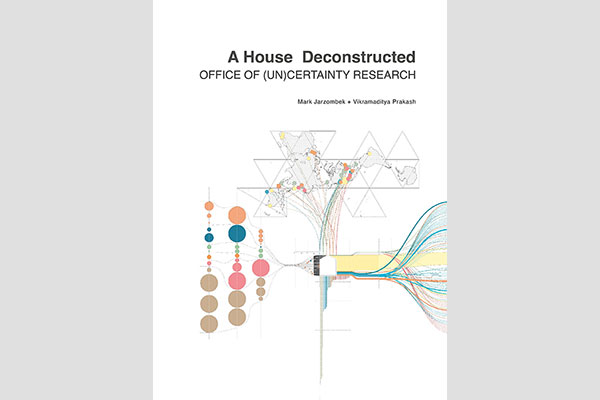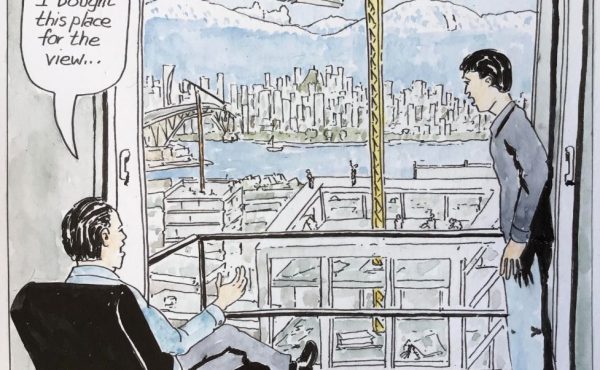
Authors: Mark Jarzombek and Vikramaditya Prakash (Actar, 2023)
In an era of mounting ecological urgency and deepening social inequity, it has never been more critical to examine how buildings participate in global systems of impact—environmental, economic, and political. A House Deconstructed by Mark Jarzombek and Vikramaditya Prakash responds to this imperative with conceptual boldness and accessible clarity.
As with many powerful books, its premise is deceptively simple: to uncover the hidden global interconnections behind the components of a newly constructed house. In doing so, the authors dismantle the notion of the house as a self-contained, knowable object—revealing it instead as an artifact shaped by, and shaping, forces far beyond the domestic realm.
The book draws from an intensive, three-year investigation by the Office for Uncertainty Research (O(U)R), focused on the construction of a modest house in Seattle. This research unfolds across four investigative “registers,” each narrating a compelling story:
- Atomic Consciousness – tracing materials back to the origins of the universe
- Production Consciousness – examining how raw materials become building components
- Labour Consciousness – uncovering the human costs and conditions of construction
- Source Consciousness – mapping the global systems that deliver architectural materials
This inquiry formed the basis for Many Houses, Many Worlds, the two-part O(U)R Research Station exhibit at the 2021 Venice Biennale.
Despite its exhaustive approach, much of the house’s material and social history remains elusive—a central lesson of the book. Workers are often underpaid, injured, or exposed to harmful conditions, yet these realities are hidden by poor documentation, global logistical complexity, or deliberate concealment. The authors emphasize that this opacity is not accidental—it is built into the way architecture is practiced and produced.
The book foregrounds several core ideas: that buildings are more uncertain and entangled than they appear; that both visible and invisible forces shape them; and that the vast scale of architectural production defies simplistic understanding. Rather than viewing these insights as limitations, the authors harness them to provoke critical reflection.
How should we teach and practice architecture in light of these truths?
Today, they argue, dwelling is marked by profound disconnection. Yet it remains a powerful site of identity and belonging. Architecture often conceals these contradictions behind polished finishes and professional certainty. If we are to take responsibility—for sustainability, equity, and the lives and landscapes buildings affect—we must confront what has long been silenced.
A House Deconstructed offers no easy answers. Instead, it opens space for deeper inquiry. Its nonlinear, essayistic, and interdisciplinary structure mirrors the complexity it interrogates. Chapters move fluidly from everyday rituals to industrial systems to colonial legacies, each offering a new vantage point for rethinking what a house is.
The book’s visuals—diagrams and provocative photographs—do more than illustrate; they challenge us to see differently. They expose the illusion of architecture’s supposed neutrality and order.
One of the book’s major strengths is its global perspective. By placing diverse traditions and domestic forms in conversation, the authors reveal how even a simple freestanding house is enmeshed in global histories of extraction, migration, and resistance. In doing so, they reframe architecture as not merely local, but fundamentally planetary in scope.
Extending this research to more complex buildings—or entire cities—is overwhelming in the best way. It highlights how much we take for granted in a world shaped by rapid urbanization and growth agendas that rely on deeply extractive and unsustainable architectural and building practices.
In The Art of Architectural Grafting, Jeanne Gang argues that we must do “much more while using less,” asking pointedly:
“When you need to build, what should be done when the best answer might not be to build at all?”
A House Deconstructed lends substance to Gang’s urgent call for restraint. It makes a compelling case that continuing with business-as-usual construction is no longer tenable. These themes also resonate in the forthcoming book A Moratorium on New Construction. Perhaps a Movement is afoot?
While grounded in architectural theory, A House Deconstructed speaks to a broad audience. It is a vital resource for anyone interested in thinking critically about how we build—and why. The book doesn’t demand technical expertise; it calls for ethical curiosity.
Ultimately, A House Deconstructed isn’t about perfecting buildings. It’s about exposing the systems behind them—and imagining a more honest, equitable, and reflective architectural practice. In a world built so often on erasure, this book is a call to remember—and to rebuild with care.
***
For more information on A House Deconstructed, visit the Actar website.
**
Erick Villagomez is the Editor-in-Chief at Spacing Vancouver and teaches at UBC’s School of Community and Regional Planning. He is also the author of The Laws of Settlements: 54 Laws Underlying Settlements Across Scale and Culture.




